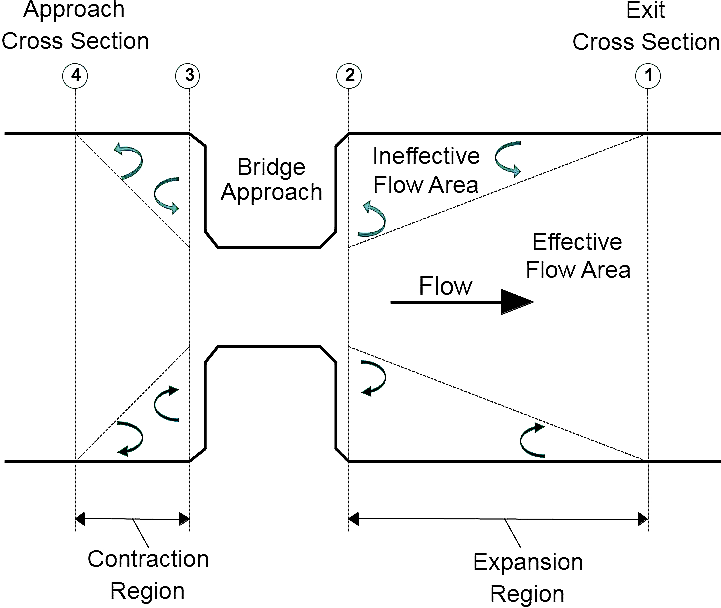
Losses due to contraction and expansion of flow between cross sections are determined during the HEC‑RAS standard step profile calculations. Manning’s equation is used to calculate friction losses, and all other losses are described in terms of a coefficient times the absolute value of the change in velocity head between adjacent cross sections. When the velocity head increases in the downstream direction, a contraction coefficient is used; and when the velocity head decreases, an expansion coefficient is used.
Roadway Crossing Flow Contraction & Expansion
The below figure shows the contraction and expansion of flow as it passes through a bridge or culvert opening at a roadway crossing.

As shown in the above figure, flow contraction occurs between cross sections 4 and 3, while the flow expansion occurs between sections 2 and 1. The contraction and expansion coefficients are used to compute energy losses associated with changes in the shape of river cross‑sections (or effective flow areas). The loss due to expansion of flow is usually larger than the contraction loss, and losses from short abrupt transitions are larger than losses from gradual transitions.
Subcritical Flow Contraction & Expansion Coefficients
Typical values for contraction and expansion coefficients for subcritical flow conditions are shown in the below table. The maximum value for the contraction and expansion coefficient is 1.0.
Table 1
Subcritical Flow Contraction and Expansion Coefficients
| | Contraction | Expansion |
| No transition loss computed | 0 | 0 |
| Gradual transitions | 0.1 | 0.3 |
| Typical bridge sections | 0.3 | 0.5 |
| Abrupt transitions | 0.6 | 0.8 |
Supercritical Flow Contraction & Expansion Coefficients
In general, contraction and expansion coefficients for supercritical flow are lower than for subcritical flow. For typical bridges that are under class C flow conditions (totally supercritical flow), the contraction and expansion coefficients should be around 0.03 and 0.05 respectively. For abrupt bridge transitions under class C flow, values of 0.05 and 0.1 may be more appropriate.
